Commercial Law: Partnership and Liability
VerifiedAdded on 2023/03/29
|12
|3432
|386
AI Summary
This document discusses the concept of partnership in commercial law and explores the liability of partners. It also examines the possibility of claiming damages and making changes to the business structure.
Contribute Materials
Your contribution can guide someone’s learning journey. Share your
documents today.
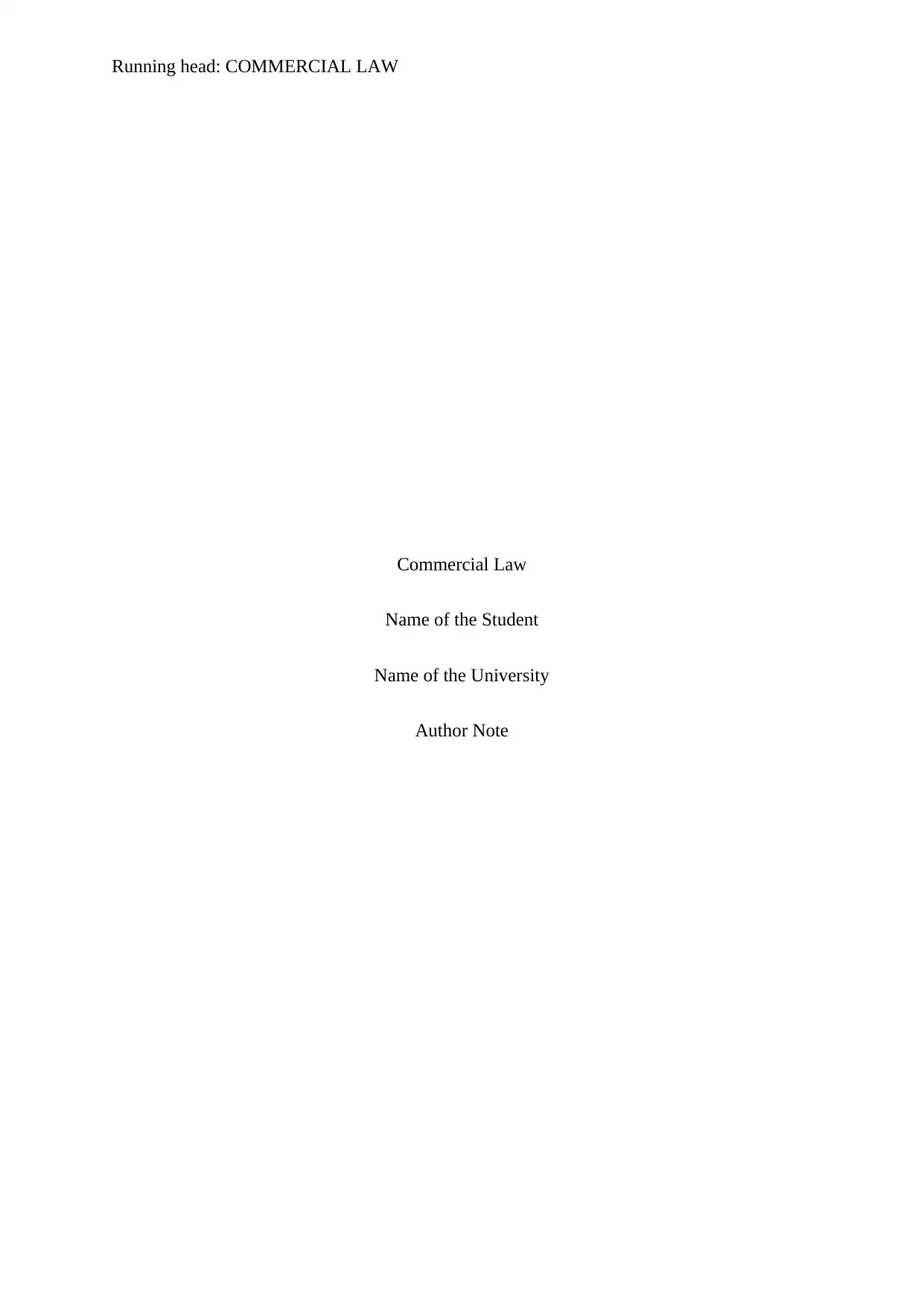
Running head: COMMERCIAL LAW
Commercial Law
Name of the Student
Name of the University
Author Note
Commercial Law
Name of the Student
Name of the University
Author Note
Secure Best Marks with AI Grader
Need help grading? Try our AI Grader for instant feedback on your assignments.
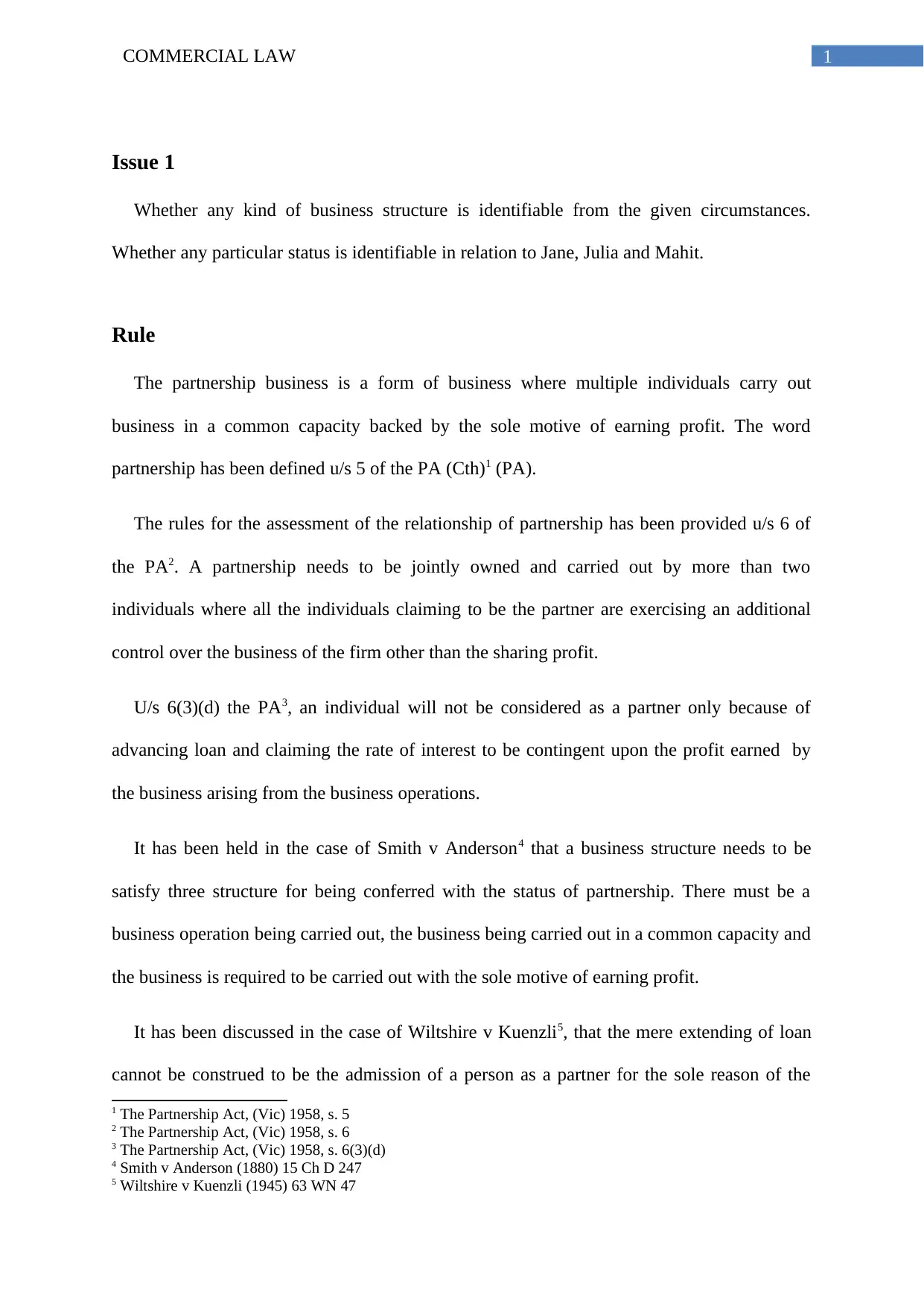
1COMMERCIAL LAW
Issue 1
Whether any kind of business structure is identifiable from the given circumstances.
Whether any particular status is identifiable in relation to Jane, Julia and Mahit.
Rule
The partnership business is a form of business where multiple individuals carry out
business in a common capacity backed by the sole motive of earning profit. The word
partnership has been defined u/s 5 of the PA (Cth)1 (PA).
The rules for the assessment of the relationship of partnership has been provided u/s 6 of
the PA2. A partnership needs to be jointly owned and carried out by more than two
individuals where all the individuals claiming to be the partner are exercising an additional
control over the business of the firm other than the sharing profit.
U/s 6(3)(d) the PA3, an individual will not be considered as a partner only because of
advancing loan and claiming the rate of interest to be contingent upon the profit earned by
the business arising from the business operations.
It has been held in the case of Smith v Anderson4 that a business structure needs to be
satisfy three structure for being conferred with the status of partnership. There must be a
business operation being carried out, the business being carried out in a common capacity and
the business is required to be carried out with the sole motive of earning profit.
It has been discussed in the case of Wiltshire v Kuenzli5, that the mere extending of loan
cannot be construed to be the admission of a person as a partner for the sole reason of the
1 The Partnership Act, (Vic) 1958, s. 5
2 The Partnership Act, (Vic) 1958, s. 6
3 The Partnership Act, (Vic) 1958, s. 6(3)(d)
4 Smith v Anderson (1880) 15 Ch D 247
5 Wiltshire v Kuenzli (1945) 63 WN 47
Issue 1
Whether any kind of business structure is identifiable from the given circumstances.
Whether any particular status is identifiable in relation to Jane, Julia and Mahit.
Rule
The partnership business is a form of business where multiple individuals carry out
business in a common capacity backed by the sole motive of earning profit. The word
partnership has been defined u/s 5 of the PA (Cth)1 (PA).
The rules for the assessment of the relationship of partnership has been provided u/s 6 of
the PA2. A partnership needs to be jointly owned and carried out by more than two
individuals where all the individuals claiming to be the partner are exercising an additional
control over the business of the firm other than the sharing profit.
U/s 6(3)(d) the PA3, an individual will not be considered as a partner only because of
advancing loan and claiming the rate of interest to be contingent upon the profit earned by
the business arising from the business operations.
It has been held in the case of Smith v Anderson4 that a business structure needs to be
satisfy three structure for being conferred with the status of partnership. There must be a
business operation being carried out, the business being carried out in a common capacity and
the business is required to be carried out with the sole motive of earning profit.
It has been discussed in the case of Wiltshire v Kuenzli5, that the mere extending of loan
cannot be construed to be the admission of a person as a partner for the sole reason of the
1 The Partnership Act, (Vic) 1958, s. 5
2 The Partnership Act, (Vic) 1958, s. 6
3 The Partnership Act, (Vic) 1958, s. 6(3)(d)
4 Smith v Anderson (1880) 15 Ch D 247
5 Wiltshire v Kuenzli (1945) 63 WN 47

2COMMERCIAL LAW
interest of the loan being paid out of the interest as well as being contingent upon the interest.
An additional control will be required to be conferred and exercised by the person to be
rendered as a partner in the firm.
Application
In the present instance, Jia and Jane resolved to create their owing range of lipstick –
Rouge and they decided to utilise the online mode for marketing their product over the social
media. Both Jia and Jane has invested their own monetary resources for the placing an order
for a small batch of lipstick to a cosmetics manufacture. This need to be viewed under the
light of the element of partnership as provided under the PA as well as the common law.
There is an operation of business being carried out between Jia and Jane while promoting
their product. There is a motive of carrying earning profit as well as they have been jointly
carrying out the profit. Hence, they can be said to have carried out partnership business as per
the provisions u/s 6 of the PA6 as well as the principles established in the case of Smith v
Anderson7.
Mahit has advanced a loan to the business carried out by Jane and Jia. But Mahit has
extended that loan with the sole intention of assisting her friend and has no intention of
exercising any additional control over the business. However, he has been remitted with the
amount out of the profit after the shares of Jane and Jia being deducted. Hence, although Jane
and Jia can treated as partners, Mahit cannot be treated as a partner as provided U/s 6(3)(d)
the PA8 as well as under the principles established in the case of Wiltshire v Kuenzli9 that the
mere extending of loan cannot be construed to be the admission of a person as a partner for
the sole reason of the interest of the loan being paid out of the interest as well as being
6 The Partnership Act, (Vic) 1958, s. 6
7 Smith v Anderson (1880) 15 Ch D 247
8 The Partnership Act, (Vic) 1958, s. 6(3)(d)
9 Wiltshire v Kuenzli (1945) 63 WN 47
interest of the loan being paid out of the interest as well as being contingent upon the interest.
An additional control will be required to be conferred and exercised by the person to be
rendered as a partner in the firm.
Application
In the present instance, Jia and Jane resolved to create their owing range of lipstick –
Rouge and they decided to utilise the online mode for marketing their product over the social
media. Both Jia and Jane has invested their own monetary resources for the placing an order
for a small batch of lipstick to a cosmetics manufacture. This need to be viewed under the
light of the element of partnership as provided under the PA as well as the common law.
There is an operation of business being carried out between Jia and Jane while promoting
their product. There is a motive of carrying earning profit as well as they have been jointly
carrying out the profit. Hence, they can be said to have carried out partnership business as per
the provisions u/s 6 of the PA6 as well as the principles established in the case of Smith v
Anderson7.
Mahit has advanced a loan to the business carried out by Jane and Jia. But Mahit has
extended that loan with the sole intention of assisting her friend and has no intention of
exercising any additional control over the business. However, he has been remitted with the
amount out of the profit after the shares of Jane and Jia being deducted. Hence, although Jane
and Jia can treated as partners, Mahit cannot be treated as a partner as provided U/s 6(3)(d)
the PA8 as well as under the principles established in the case of Wiltshire v Kuenzli9 that the
mere extending of loan cannot be construed to be the admission of a person as a partner for
the sole reason of the interest of the loan being paid out of the interest as well as being
6 The Partnership Act, (Vic) 1958, s. 6
7 Smith v Anderson (1880) 15 Ch D 247
8 The Partnership Act, (Vic) 1958, s. 6(3)(d)
9 Wiltshire v Kuenzli (1945) 63 WN 47
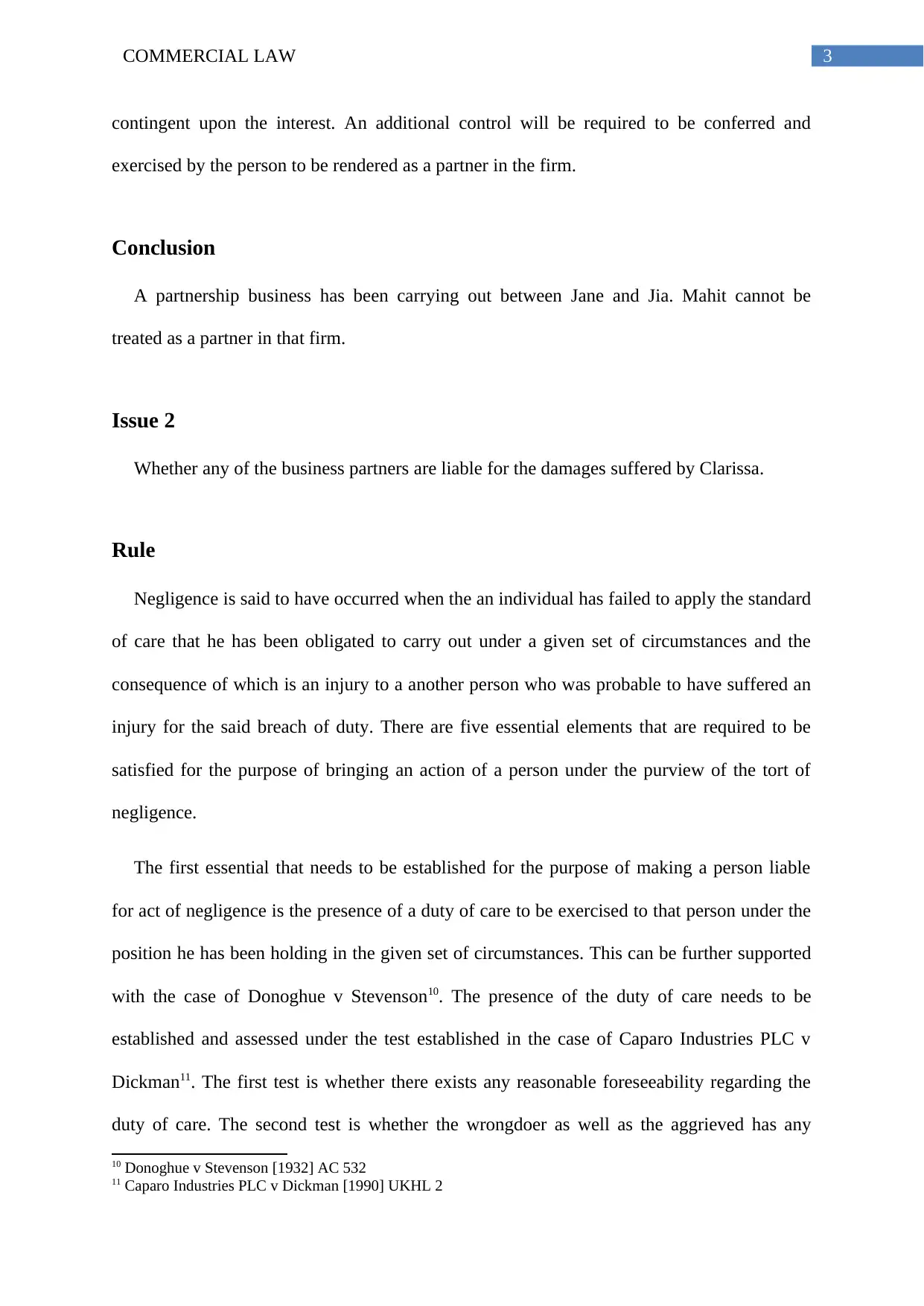
3COMMERCIAL LAW
contingent upon the interest. An additional control will be required to be conferred and
exercised by the person to be rendered as a partner in the firm.
Conclusion
A partnership business has been carrying out between Jane and Jia. Mahit cannot be
treated as a partner in that firm.
Issue 2
Whether any of the business partners are liable for the damages suffered by Clarissa.
Rule
Negligence is said to have occurred when the an individual has failed to apply the standard
of care that he has been obligated to carry out under a given set of circumstances and the
consequence of which is an injury to a another person who was probable to have suffered an
injury for the said breach of duty. There are five essential elements that are required to be
satisfied for the purpose of bringing an action of a person under the purview of the tort of
negligence.
The first essential that needs to be established for the purpose of making a person liable
for act of negligence is the presence of a duty of care to be exercised to that person under the
position he has been holding in the given set of circumstances. This can be further supported
with the case of Donoghue v Stevenson10. The presence of the duty of care needs to be
established and assessed under the test established in the case of Caparo Industries PLC v
Dickman11. The first test is whether there exists any reasonable foreseeability regarding the
duty of care. The second test is whether the wrongdoer as well as the aggrieved has any
10 Donoghue v Stevenson [1932] AC 532
11 Caparo Industries PLC v Dickman [1990] UKHL 2
contingent upon the interest. An additional control will be required to be conferred and
exercised by the person to be rendered as a partner in the firm.
Conclusion
A partnership business has been carrying out between Jane and Jia. Mahit cannot be
treated as a partner in that firm.
Issue 2
Whether any of the business partners are liable for the damages suffered by Clarissa.
Rule
Negligence is said to have occurred when the an individual has failed to apply the standard
of care that he has been obligated to carry out under a given set of circumstances and the
consequence of which is an injury to a another person who was probable to have suffered an
injury for the said breach of duty. There are five essential elements that are required to be
satisfied for the purpose of bringing an action of a person under the purview of the tort of
negligence.
The first essential that needs to be established for the purpose of making a person liable
for act of negligence is the presence of a duty of care to be exercised to that person under the
position he has been holding in the given set of circumstances. This can be further supported
with the case of Donoghue v Stevenson10. The presence of the duty of care needs to be
established and assessed under the test established in the case of Caparo Industries PLC v
Dickman11. The first test is whether there exists any reasonable foreseeability regarding the
duty of care. The second test is whether the wrongdoer as well as the aggrieved has any
10 Donoghue v Stevenson [1932] AC 532
11 Caparo Industries PLC v Dickman [1990] UKHL 2
Secure Best Marks with AI Grader
Need help grading? Try our AI Grader for instant feedback on your assignments.
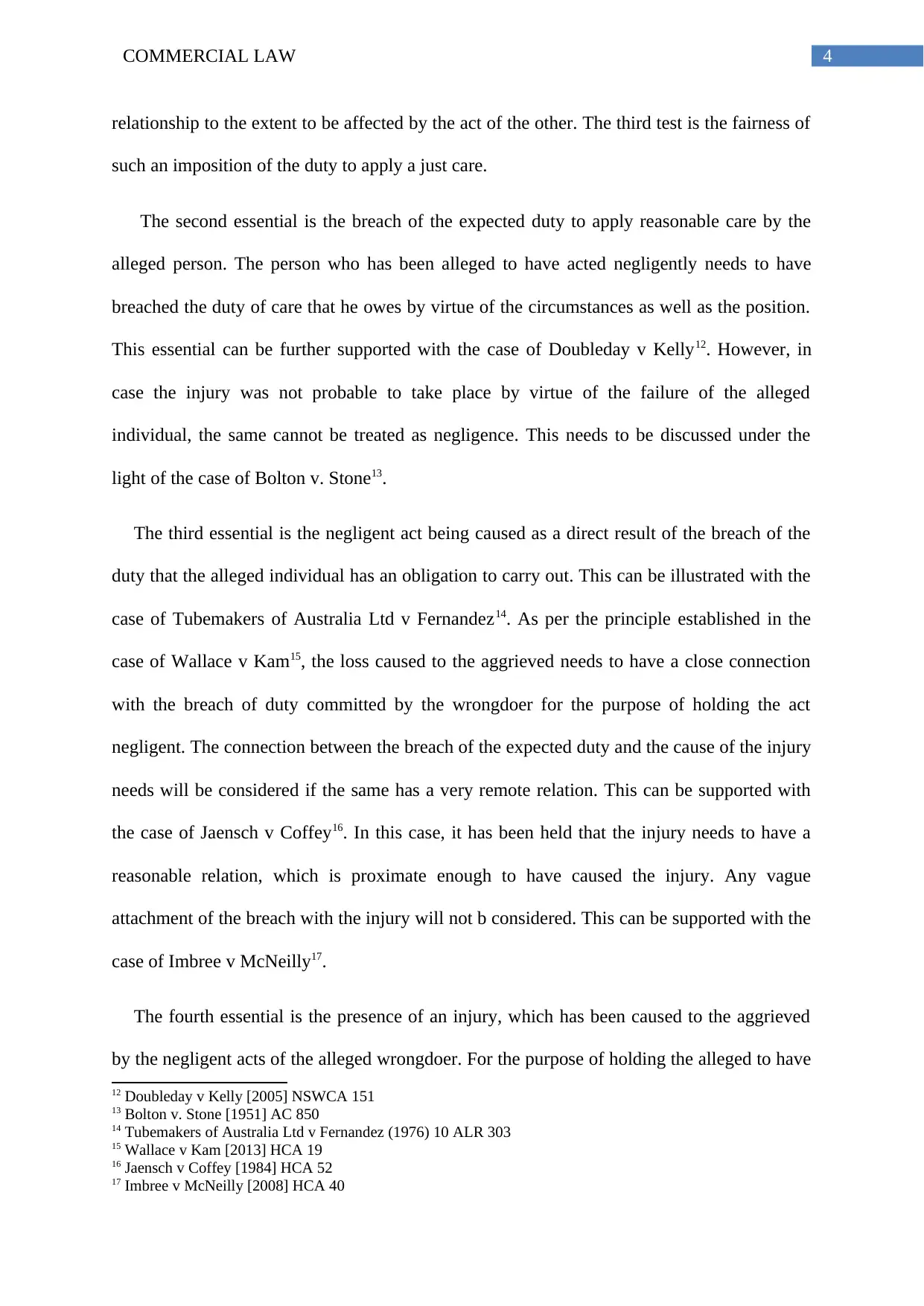
4COMMERCIAL LAW
relationship to the extent to be affected by the act of the other. The third test is the fairness of
such an imposition of the duty to apply a just care.
The second essential is the breach of the expected duty to apply reasonable care by the
alleged person. The person who has been alleged to have acted negligently needs to have
breached the duty of care that he owes by virtue of the circumstances as well as the position.
This essential can be further supported with the case of Doubleday v Kelly12. However, in
case the injury was not probable to take place by virtue of the failure of the alleged
individual, the same cannot be treated as negligence. This needs to be discussed under the
light of the case of Bolton v. Stone13.
The third essential is the negligent act being caused as a direct result of the breach of the
duty that the alleged individual has an obligation to carry out. This can be illustrated with the
case of Tubemakers of Australia Ltd v Fernandez14. As per the principle established in the
case of Wallace v Kam15, the loss caused to the aggrieved needs to have a close connection
with the breach of duty committed by the wrongdoer for the purpose of holding the act
negligent. The connection between the breach of the expected duty and the cause of the injury
needs will be considered if the same has a very remote relation. This can be supported with
the case of Jaensch v Coffey16. In this case, it has been held that the injury needs to have a
reasonable relation, which is proximate enough to have caused the injury. Any vague
attachment of the breach with the injury will not b considered. This can be supported with the
case of Imbree v McNeilly17.
The fourth essential is the presence of an injury, which has been caused to the aggrieved
by the negligent acts of the alleged wrongdoer. For the purpose of holding the alleged to have
12 Doubleday v Kelly [2005] NSWCA 151
13 Bolton v. Stone [1951] AC 850
14 Tubemakers of Australia Ltd v Fernandez (1976) 10 ALR 303
15 Wallace v Kam [2013] HCA 19
16 Jaensch v Coffey [1984] HCA 52
17 Imbree v McNeilly [2008] HCA 40
relationship to the extent to be affected by the act of the other. The third test is the fairness of
such an imposition of the duty to apply a just care.
The second essential is the breach of the expected duty to apply reasonable care by the
alleged person. The person who has been alleged to have acted negligently needs to have
breached the duty of care that he owes by virtue of the circumstances as well as the position.
This essential can be further supported with the case of Doubleday v Kelly12. However, in
case the injury was not probable to take place by virtue of the failure of the alleged
individual, the same cannot be treated as negligence. This needs to be discussed under the
light of the case of Bolton v. Stone13.
The third essential is the negligent act being caused as a direct result of the breach of the
duty that the alleged individual has an obligation to carry out. This can be illustrated with the
case of Tubemakers of Australia Ltd v Fernandez14. As per the principle established in the
case of Wallace v Kam15, the loss caused to the aggrieved needs to have a close connection
with the breach of duty committed by the wrongdoer for the purpose of holding the act
negligent. The connection between the breach of the expected duty and the cause of the injury
needs will be considered if the same has a very remote relation. This can be supported with
the case of Jaensch v Coffey16. In this case, it has been held that the injury needs to have a
reasonable relation, which is proximate enough to have caused the injury. Any vague
attachment of the breach with the injury will not b considered. This can be supported with the
case of Imbree v McNeilly17.
The fourth essential is the presence of an injury, which has been caused to the aggrieved
by the negligent acts of the alleged wrongdoer. For the purpose of holding the alleged to have
12 Doubleday v Kelly [2005] NSWCA 151
13 Bolton v. Stone [1951] AC 850
14 Tubemakers of Australia Ltd v Fernandez (1976) 10 ALR 303
15 Wallace v Kam [2013] HCA 19
16 Jaensch v Coffey [1984] HCA 52
17 Imbree v McNeilly [2008] HCA 40
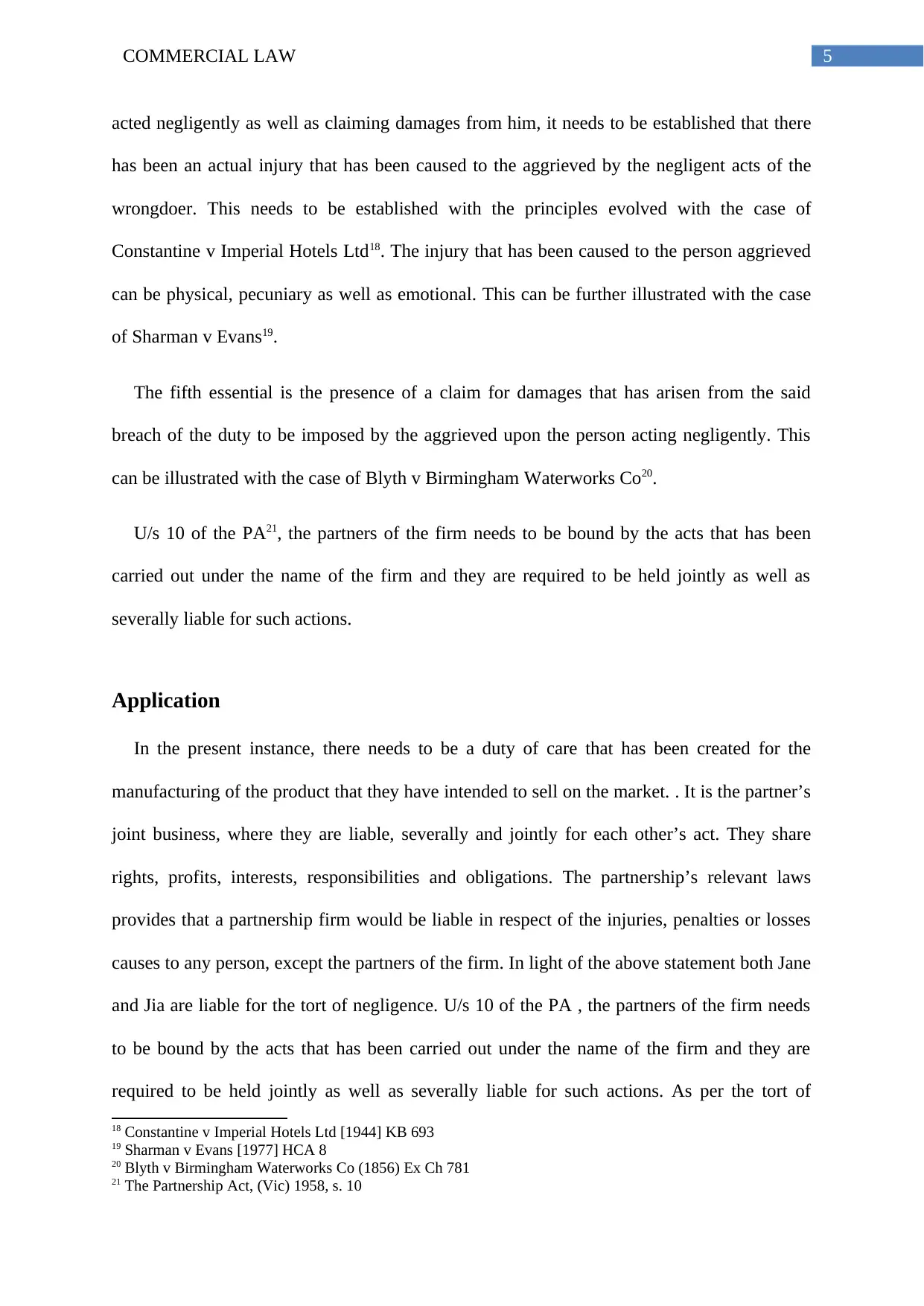
5COMMERCIAL LAW
acted negligently as well as claiming damages from him, it needs to be established that there
has been an actual injury that has been caused to the aggrieved by the negligent acts of the
wrongdoer. This needs to be established with the principles evolved with the case of
Constantine v Imperial Hotels Ltd18. The injury that has been caused to the person aggrieved
can be physical, pecuniary as well as emotional. This can be further illustrated with the case
of Sharman v Evans19.
The fifth essential is the presence of a claim for damages that has arisen from the said
breach of the duty to be imposed by the aggrieved upon the person acting negligently. This
can be illustrated with the case of Blyth v Birmingham Waterworks Co20.
U/s 10 of the PA21, the partners of the firm needs to be bound by the acts that has been
carried out under the name of the firm and they are required to be held jointly as well as
severally liable for such actions.
Application
In the present instance, there needs to be a duty of care that has been created for the
manufacturing of the product that they have intended to sell on the market. . It is the partner’s
joint business, where they are liable, severally and jointly for each other’s act. They share
rights, profits, interests, responsibilities and obligations. The partnership’s relevant laws
provides that a partnership firm would be liable in respect of the injuries, penalties or losses
causes to any person, except the partners of the firm. In light of the above statement both Jane
and Jia are liable for the tort of negligence. U/s 10 of the PA , the partners of the firm needs
to be bound by the acts that has been carried out under the name of the firm and they are
required to be held jointly as well as severally liable for such actions. As per the tort of
18 Constantine v Imperial Hotels Ltd [1944] KB 693
19 Sharman v Evans [1977] HCA 8
20 Blyth v Birmingham Waterworks Co (1856) Ex Ch 781
21 The Partnership Act, (Vic) 1958, s. 10
acted negligently as well as claiming damages from him, it needs to be established that there
has been an actual injury that has been caused to the aggrieved by the negligent acts of the
wrongdoer. This needs to be established with the principles evolved with the case of
Constantine v Imperial Hotels Ltd18. The injury that has been caused to the person aggrieved
can be physical, pecuniary as well as emotional. This can be further illustrated with the case
of Sharman v Evans19.
The fifth essential is the presence of a claim for damages that has arisen from the said
breach of the duty to be imposed by the aggrieved upon the person acting negligently. This
can be illustrated with the case of Blyth v Birmingham Waterworks Co20.
U/s 10 of the PA21, the partners of the firm needs to be bound by the acts that has been
carried out under the name of the firm and they are required to be held jointly as well as
severally liable for such actions.
Application
In the present instance, there needs to be a duty of care that has been created for the
manufacturing of the product that they have intended to sell on the market. . It is the partner’s
joint business, where they are liable, severally and jointly for each other’s act. They share
rights, profits, interests, responsibilities and obligations. The partnership’s relevant laws
provides that a partnership firm would be liable in respect of the injuries, penalties or losses
causes to any person, except the partners of the firm. In light of the above statement both Jane
and Jia are liable for the tort of negligence. U/s 10 of the PA , the partners of the firm needs
to be bound by the acts that has been carried out under the name of the firm and they are
required to be held jointly as well as severally liable for such actions. As per the tort of
18 Constantine v Imperial Hotels Ltd [1944] KB 693
19 Sharman v Evans [1977] HCA 8
20 Blyth v Birmingham Waterworks Co (1856) Ex Ch 781
21 The Partnership Act, (Vic) 1958, s. 10
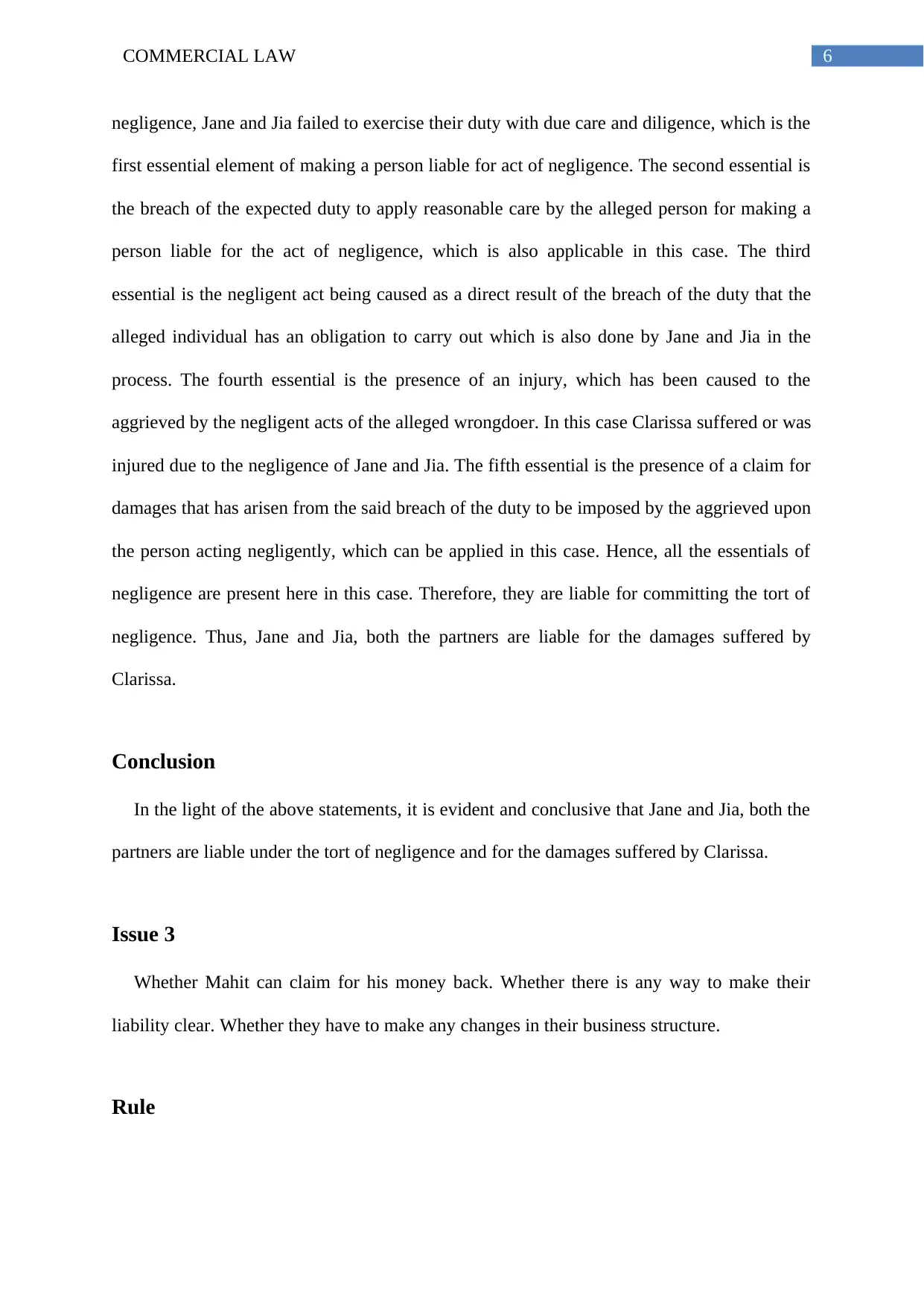
6COMMERCIAL LAW
negligence, Jane and Jia failed to exercise their duty with due care and diligence, which is the
first essential element of making a person liable for act of negligence. The second essential is
the breach of the expected duty to apply reasonable care by the alleged person for making a
person liable for the act of negligence, which is also applicable in this case. The third
essential is the negligent act being caused as a direct result of the breach of the duty that the
alleged individual has an obligation to carry out which is also done by Jane and Jia in the
process. The fourth essential is the presence of an injury, which has been caused to the
aggrieved by the negligent acts of the alleged wrongdoer. In this case Clarissa suffered or was
injured due to the negligence of Jane and Jia. The fifth essential is the presence of a claim for
damages that has arisen from the said breach of the duty to be imposed by the aggrieved upon
the person acting negligently, which can be applied in this case. Hence, all the essentials of
negligence are present here in this case. Therefore, they are liable for committing the tort of
negligence. Thus, Jane and Jia, both the partners are liable for the damages suffered by
Clarissa.
Conclusion
In the light of the above statements, it is evident and conclusive that Jane and Jia, both the
partners are liable under the tort of negligence and for the damages suffered by Clarissa.
Issue 3
Whether Mahit can claim for his money back. Whether there is any way to make their
liability clear. Whether they have to make any changes in their business structure.
Rule
negligence, Jane and Jia failed to exercise their duty with due care and diligence, which is the
first essential element of making a person liable for act of negligence. The second essential is
the breach of the expected duty to apply reasonable care by the alleged person for making a
person liable for the act of negligence, which is also applicable in this case. The third
essential is the negligent act being caused as a direct result of the breach of the duty that the
alleged individual has an obligation to carry out which is also done by Jane and Jia in the
process. The fourth essential is the presence of an injury, which has been caused to the
aggrieved by the negligent acts of the alleged wrongdoer. In this case Clarissa suffered or was
injured due to the negligence of Jane and Jia. The fifth essential is the presence of a claim for
damages that has arisen from the said breach of the duty to be imposed by the aggrieved upon
the person acting negligently, which can be applied in this case. Hence, all the essentials of
negligence are present here in this case. Therefore, they are liable for committing the tort of
negligence. Thus, Jane and Jia, both the partners are liable for the damages suffered by
Clarissa.
Conclusion
In the light of the above statements, it is evident and conclusive that Jane and Jia, both the
partners are liable under the tort of negligence and for the damages suffered by Clarissa.
Issue 3
Whether Mahit can claim for his money back. Whether there is any way to make their
liability clear. Whether they have to make any changes in their business structure.
Rule
Paraphrase This Document
Need a fresh take? Get an instant paraphrase of this document with our AI Paraphraser
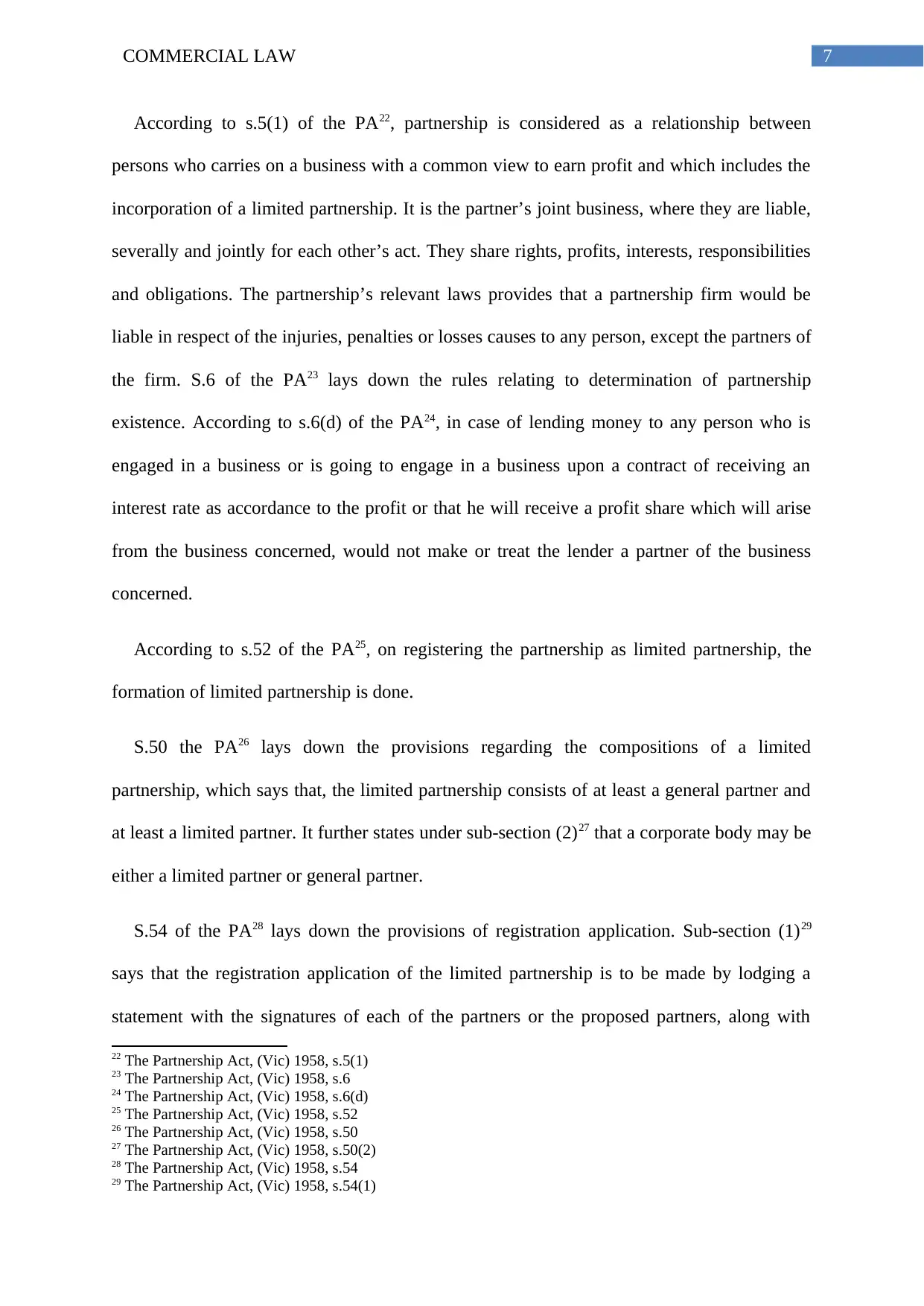
7COMMERCIAL LAW
According to s.5(1) of the PA22, partnership is considered as a relationship between
persons who carries on a business with a common view to earn profit and which includes the
incorporation of a limited partnership. It is the partner’s joint business, where they are liable,
severally and jointly for each other’s act. They share rights, profits, interests, responsibilities
and obligations. The partnership’s relevant laws provides that a partnership firm would be
liable in respect of the injuries, penalties or losses causes to any person, except the partners of
the firm. S.6 of the PA23 lays down the rules relating to determination of partnership
existence. According to s.6(d) of the PA24, in case of lending money to any person who is
engaged in a business or is going to engage in a business upon a contract of receiving an
interest rate as accordance to the profit or that he will receive a profit share which will arise
from the business concerned, would not make or treat the lender a partner of the business
concerned.
According to s.52 of the PA25, on registering the partnership as limited partnership, the
formation of limited partnership is done.
S.50 the PA26 lays down the provisions regarding the compositions of a limited
partnership, which says that, the limited partnership consists of at least a general partner and
at least a limited partner. It further states under sub-section (2)27 that a corporate body may be
either a limited partner or general partner.
S.54 of the PA28 lays down the provisions of registration application. Sub-section (1)29
says that the registration application of the limited partnership is to be made by lodging a
statement with the signatures of each of the partners or the proposed partners, along with
22 The Partnership Act, (Vic) 1958, s.5(1)
23 The Partnership Act, (Vic) 1958, s.6
24 The Partnership Act, (Vic) 1958, s.6(d)
25 The Partnership Act, (Vic) 1958, s.52
26 The Partnership Act, (Vic) 1958, s.50
27 The Partnership Act, (Vic) 1958, s.50(2)
28 The Partnership Act, (Vic) 1958, s.54
29 The Partnership Act, (Vic) 1958, s.54(1)
According to s.5(1) of the PA22, partnership is considered as a relationship between
persons who carries on a business with a common view to earn profit and which includes the
incorporation of a limited partnership. It is the partner’s joint business, where they are liable,
severally and jointly for each other’s act. They share rights, profits, interests, responsibilities
and obligations. The partnership’s relevant laws provides that a partnership firm would be
liable in respect of the injuries, penalties or losses causes to any person, except the partners of
the firm. S.6 of the PA23 lays down the rules relating to determination of partnership
existence. According to s.6(d) of the PA24, in case of lending money to any person who is
engaged in a business or is going to engage in a business upon a contract of receiving an
interest rate as accordance to the profit or that he will receive a profit share which will arise
from the business concerned, would not make or treat the lender a partner of the business
concerned.
According to s.52 of the PA25, on registering the partnership as limited partnership, the
formation of limited partnership is done.
S.50 the PA26 lays down the provisions regarding the compositions of a limited
partnership, which says that, the limited partnership consists of at least a general partner and
at least a limited partner. It further states under sub-section (2)27 that a corporate body may be
either a limited partner or general partner.
S.54 of the PA28 lays down the provisions of registration application. Sub-section (1)29
says that the registration application of the limited partnership is to be made by lodging a
statement with the signatures of each of the partners or the proposed partners, along with
22 The Partnership Act, (Vic) 1958, s.5(1)
23 The Partnership Act, (Vic) 1958, s.6
24 The Partnership Act, (Vic) 1958, s.6(d)
25 The Partnership Act, (Vic) 1958, s.52
26 The Partnership Act, (Vic) 1958, s.50
27 The Partnership Act, (Vic) 1958, s.50(2)
28 The Partnership Act, (Vic) 1958, s.54
29 The Partnership Act, (Vic) 1958, s.54(1)
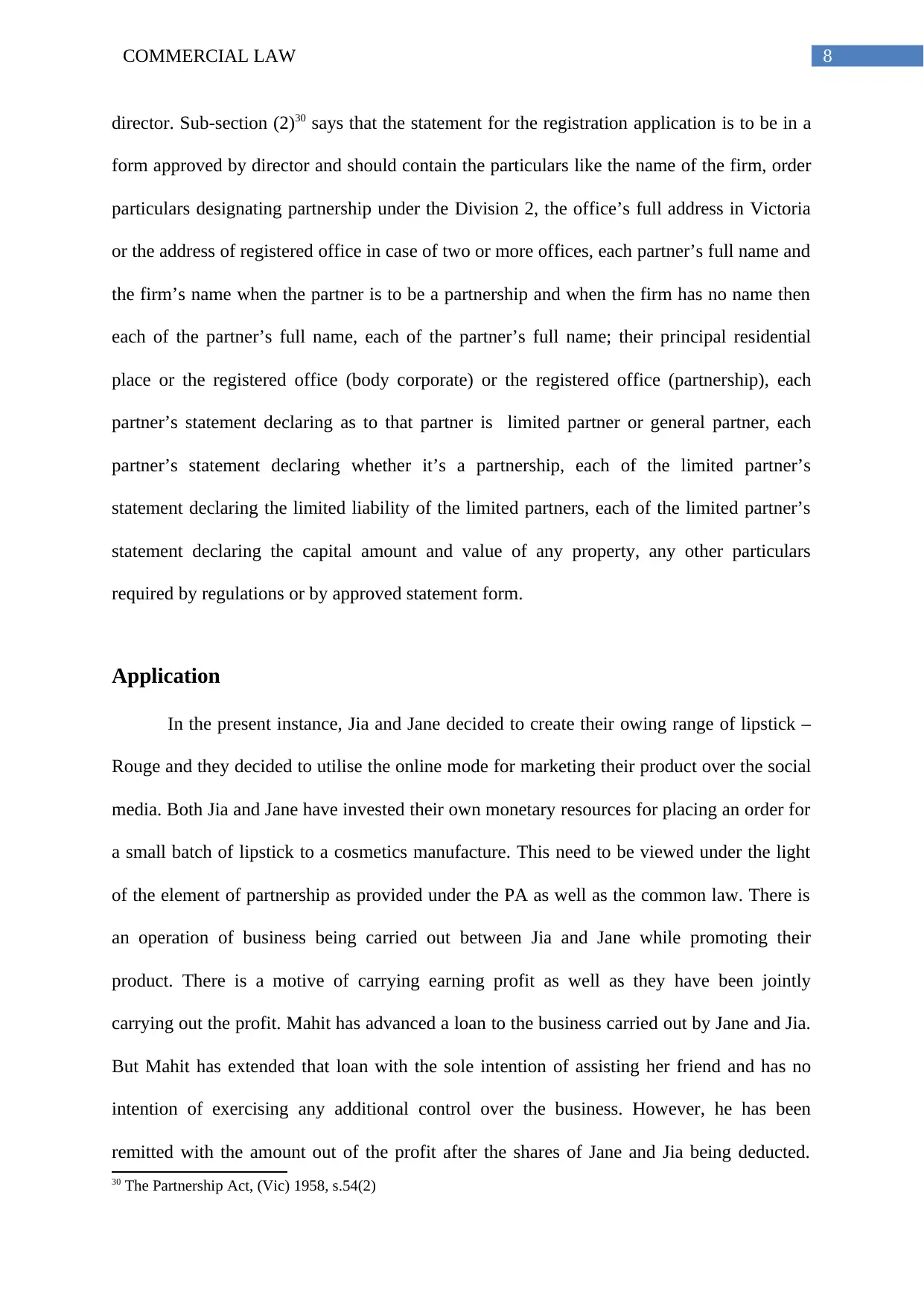
8COMMERCIAL LAW
director. Sub-section (2)30 says that the statement for the registration application is to be in a
form approved by director and should contain the particulars like the name of the firm, order
particulars designating partnership under the Division 2, the office’s full address in Victoria
or the address of registered office in case of two or more offices, each partner’s full name and
the firm’s name when the partner is to be a partnership and when the firm has no name then
each of the partner’s full name, each of the partner’s full name; their principal residential
place or the registered office (body corporate) or the registered office (partnership), each
partner’s statement declaring as to that partner is limited partner or general partner, each
partner’s statement declaring whether it’s a partnership, each of the limited partner’s
statement declaring the limited liability of the limited partners, each of the limited partner’s
statement declaring the capital amount and value of any property, any other particulars
required by regulations or by approved statement form.
Application
In the present instance, Jia and Jane decided to create their owing range of lipstick –
Rouge and they decided to utilise the online mode for marketing their product over the social
media. Both Jia and Jane have invested their own monetary resources for placing an order for
a small batch of lipstick to a cosmetics manufacture. This need to be viewed under the light
of the element of partnership as provided under the PA as well as the common law. There is
an operation of business being carried out between Jia and Jane while promoting their
product. There is a motive of carrying earning profit as well as they have been jointly
carrying out the profit. Mahit has advanced a loan to the business carried out by Jane and Jia.
But Mahit has extended that loan with the sole intention of assisting her friend and has no
intention of exercising any additional control over the business. However, he has been
remitted with the amount out of the profit after the shares of Jane and Jia being deducted.
30 The Partnership Act, (Vic) 1958, s.54(2)
director. Sub-section (2)30 says that the statement for the registration application is to be in a
form approved by director and should contain the particulars like the name of the firm, order
particulars designating partnership under the Division 2, the office’s full address in Victoria
or the address of registered office in case of two or more offices, each partner’s full name and
the firm’s name when the partner is to be a partnership and when the firm has no name then
each of the partner’s full name, each of the partner’s full name; their principal residential
place or the registered office (body corporate) or the registered office (partnership), each
partner’s statement declaring as to that partner is limited partner or general partner, each
partner’s statement declaring whether it’s a partnership, each of the limited partner’s
statement declaring the limited liability of the limited partners, each of the limited partner’s
statement declaring the capital amount and value of any property, any other particulars
required by regulations or by approved statement form.
Application
In the present instance, Jia and Jane decided to create their owing range of lipstick –
Rouge and they decided to utilise the online mode for marketing their product over the social
media. Both Jia and Jane have invested their own monetary resources for placing an order for
a small batch of lipstick to a cosmetics manufacture. This need to be viewed under the light
of the element of partnership as provided under the PA as well as the common law. There is
an operation of business being carried out between Jia and Jane while promoting their
product. There is a motive of carrying earning profit as well as they have been jointly
carrying out the profit. Mahit has advanced a loan to the business carried out by Jane and Jia.
But Mahit has extended that loan with the sole intention of assisting her friend and has no
intention of exercising any additional control over the business. However, he has been
remitted with the amount out of the profit after the shares of Jane and Jia being deducted.
30 The Partnership Act, (Vic) 1958, s.54(2)

9COMMERCIAL LAW
Hence, although Jane and Jia can treated as partners, Mahit cannot be treated as a partner as
provided U/s 6(3)(d) the PA31. Hence, Mahit has the right to claim his money back as he is
not a partner of the business concerned and has no liability in the business’s loss.
As Mahit is not a partner of the business concerned he is not liable for any of the loss
or debts of the partnership business. Jane and Jia would have all the liabilities in respect of
the loss and debts of the business concerned. In this present scenario, Mahit has the right of
claiming his money back and Jane and Jia are bound to return back the money. In order to
clear them from the liability, they need to enter into a partnership agreement with Mahit. If
Mahit enters into the partnership agreement with them then he would have the same liability
as Jane and Jia as each and every partner is bound to pay the liability or the debts of the
partnership. In order to change the partnership status of the partnership firm or in other
words, to create a partnership agreement between Jane, Jia and Mahit they need to fulfil all
the requirements of the matter concerned as directed by the Partnership Act. Hence, by
entering into partnership agreement with Mahit, Jane and Jia can clear the liability of
repaying Mahit back the money.
As Mahit is not a partner of the business run by Jane and Jia, he will not have any
liability upon the debts and losses of the business. Mahit has the right to claim his money
back and Jane and Jia are bound to return the money back to Mahit. Jane and Jia are liable to
repay the loan amount to Mahit which was obtained by Jia from Mahit. However, if Jane and
Jia can enter into a partnership agreement with Mahit, they would not have the liability to
repay the money back to Mahit. Mahit after entering into the partnership agreement with Jane
and Jia would be equally liable for the losses and debts of the partnership business. Jane and
Jia can clear their liabilities of repaying back the loan amount to Mahit. If Mahit enters into a
partnership agreement with Jane and Jia, then the number of partners in the partnership
31 The Partnership Act, (Vic) 1958, s.6(3)(d)
Hence, although Jane and Jia can treated as partners, Mahit cannot be treated as a partner as
provided U/s 6(3)(d) the PA31. Hence, Mahit has the right to claim his money back as he is
not a partner of the business concerned and has no liability in the business’s loss.
As Mahit is not a partner of the business concerned he is not liable for any of the loss
or debts of the partnership business. Jane and Jia would have all the liabilities in respect of
the loss and debts of the business concerned. In this present scenario, Mahit has the right of
claiming his money back and Jane and Jia are bound to return back the money. In order to
clear them from the liability, they need to enter into a partnership agreement with Mahit. If
Mahit enters into the partnership agreement with them then he would have the same liability
as Jane and Jia as each and every partner is bound to pay the liability or the debts of the
partnership. In order to change the partnership status of the partnership firm or in other
words, to create a partnership agreement between Jane, Jia and Mahit they need to fulfil all
the requirements of the matter concerned as directed by the Partnership Act. Hence, by
entering into partnership agreement with Mahit, Jane and Jia can clear the liability of
repaying Mahit back the money.
As Mahit is not a partner of the business run by Jane and Jia, he will not have any
liability upon the debts and losses of the business. Mahit has the right to claim his money
back and Jane and Jia are bound to return the money back to Mahit. Jane and Jia are liable to
repay the loan amount to Mahit which was obtained by Jia from Mahit. However, if Jane and
Jia can enter into a partnership agreement with Mahit, they would not have the liability to
repay the money back to Mahit. Mahit after entering into the partnership agreement with Jane
and Jia would be equally liable for the losses and debts of the partnership business. Jane and
Jia can clear their liabilities of repaying back the loan amount to Mahit. If Mahit enters into a
partnership agreement with Jane and Jia, then the number of partners in the partnership
31 The Partnership Act, (Vic) 1958, s.6(3)(d)
Secure Best Marks with AI Grader
Need help grading? Try our AI Grader for instant feedback on your assignments.
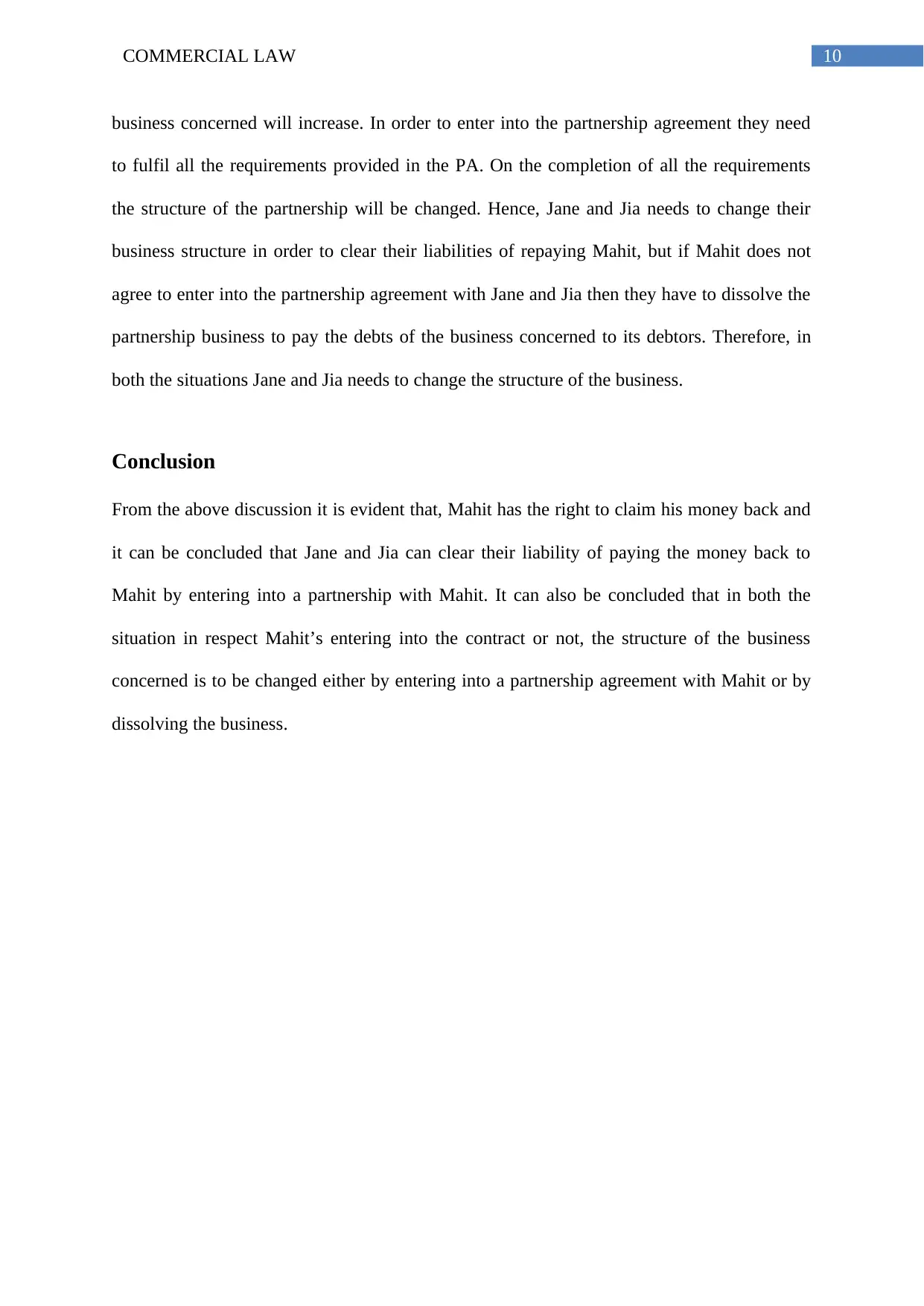
10COMMERCIAL LAW
business concerned will increase. In order to enter into the partnership agreement they need
to fulfil all the requirements provided in the PA. On the completion of all the requirements
the structure of the partnership will be changed. Hence, Jane and Jia needs to change their
business structure in order to clear their liabilities of repaying Mahit, but if Mahit does not
agree to enter into the partnership agreement with Jane and Jia then they have to dissolve the
partnership business to pay the debts of the business concerned to its debtors. Therefore, in
both the situations Jane and Jia needs to change the structure of the business.
Conclusion
From the above discussion it is evident that, Mahit has the right to claim his money back and
it can be concluded that Jane and Jia can clear their liability of paying the money back to
Mahit by entering into a partnership with Mahit. It can also be concluded that in both the
situation in respect Mahit’s entering into the contract or not, the structure of the business
concerned is to be changed either by entering into a partnership agreement with Mahit or by
dissolving the business.
business concerned will increase. In order to enter into the partnership agreement they need
to fulfil all the requirements provided in the PA. On the completion of all the requirements
the structure of the partnership will be changed. Hence, Jane and Jia needs to change their
business structure in order to clear their liabilities of repaying Mahit, but if Mahit does not
agree to enter into the partnership agreement with Jane and Jia then they have to dissolve the
partnership business to pay the debts of the business concerned to its debtors. Therefore, in
both the situations Jane and Jia needs to change the structure of the business.
Conclusion
From the above discussion it is evident that, Mahit has the right to claim his money back and
it can be concluded that Jane and Jia can clear their liability of paying the money back to
Mahit by entering into a partnership with Mahit. It can also be concluded that in both the
situation in respect Mahit’s entering into the contract or not, the structure of the business
concerned is to be changed either by entering into a partnership agreement with Mahit or by
dissolving the business.
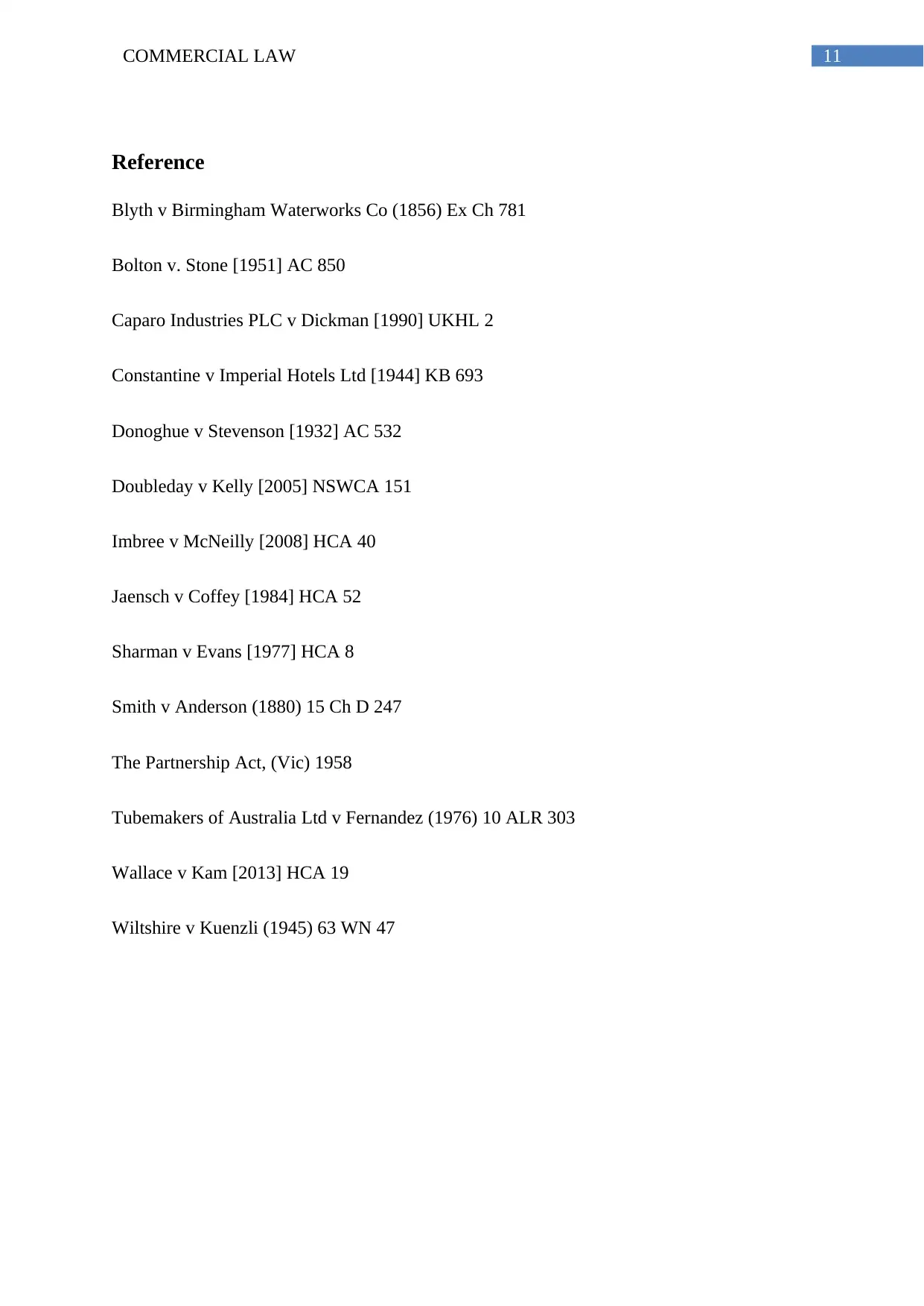
11COMMERCIAL LAW
Reference
Blyth v Birmingham Waterworks Co (1856) Ex Ch 781
Bolton v. Stone [1951] AC 850
Caparo Industries PLC v Dickman [1990] UKHL 2
Constantine v Imperial Hotels Ltd [1944] KB 693
Donoghue v Stevenson [1932] AC 532
Doubleday v Kelly [2005] NSWCA 151
Imbree v McNeilly [2008] HCA 40
Jaensch v Coffey [1984] HCA 52
Sharman v Evans [1977] HCA 8
Smith v Anderson (1880) 15 Ch D 247
The Partnership Act, (Vic) 1958
Tubemakers of Australia Ltd v Fernandez (1976) 10 ALR 303
Wallace v Kam [2013] HCA 19
Wiltshire v Kuenzli (1945) 63 WN 47
Reference
Blyth v Birmingham Waterworks Co (1856) Ex Ch 781
Bolton v. Stone [1951] AC 850
Caparo Industries PLC v Dickman [1990] UKHL 2
Constantine v Imperial Hotels Ltd [1944] KB 693
Donoghue v Stevenson [1932] AC 532
Doubleday v Kelly [2005] NSWCA 151
Imbree v McNeilly [2008] HCA 40
Jaensch v Coffey [1984] HCA 52
Sharman v Evans [1977] HCA 8
Smith v Anderson (1880) 15 Ch D 247
The Partnership Act, (Vic) 1958
Tubemakers of Australia Ltd v Fernandez (1976) 10 ALR 303
Wallace v Kam [2013] HCA 19
Wiltshire v Kuenzli (1945) 63 WN 47
1 out of 12
Related Documents
Your All-in-One AI-Powered Toolkit for Academic Success.
+13062052269
info@desklib.com
Available 24*7 on WhatsApp / Email
![[object Object]](/_next/static/media/star-bottom.7253800d.svg)
Unlock your academic potential
© 2024 | Zucol Services PVT LTD | All rights reserved.




